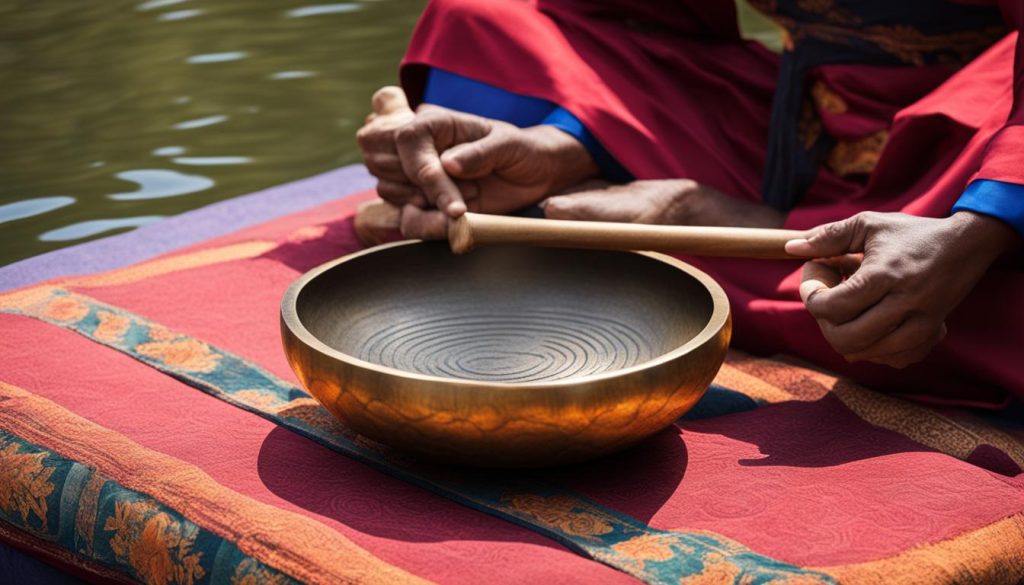
Welcome to my new guide on how to use a Tibetan singing bowl. In this article, we will explore the different techniques and methods for playing these beautiful instruments.
Whether you’re a beginner or looking to enhance your skills, we’ve got you covered. Let’s dive in and discover the captivating world of Tibetan singing bowls!
Content
Method 1: Striking
Striking a Tibetan singing bowl is a simple yet effective method for producing a rich and resonant tone.
To begin, hold the singing bowl in your non-dominant hand, ensuring a secure grip. Take the mallet, holding it like a baton, with the padded side facing the bowl’s mid-exterior wall.
Gently strike the side of the bowl with the mallet, allowing the vibrations and sound to fully dissipate before striking again.
This method is great for beginners and offers a pleasant and calming experience.
When striking the bowl, it’s important to strike it lightly and with precision.
By doing so, you allow the bowl to produce its full range of harmonics and create a clear and resonant tone.
Take your time to experiment with different striking techniques and variations in force to discover the unique sounds your singing bowl can produce.
To enhance your striking technique, try adjusting the angle and location of the strike.
By striking the bowl closer to the rim, you can produce higher-pitched tones, while striking closer to the center will result in deeper and more grounded sounds.
Each strike is an opportunity to explore the versatility of your singing bowl and discover new tones and vibrations.
| Benefits of Striking Technique | Considerations for Striking Technique |
|---|---|
|
|
Method 2: Rimming

Rimming is another technique where you will learn how to use a Tibetan singing bowl and create a unique singing sound.
While it may be more challenging than striking, with practice and patience, you can master this method.
To begin, hold the singing bowl in your non-dominant hand and grip the mallet with your thumb and forefinger in the center.
Lightly strike the bowl to “warm it up” and immediately position the mallet vertically near the rim.
Start circling the rim in a clockwise motion, similar to stirring a pot. Apply gentle pressure as the friction between the mallet and bowl produces vibrations and creates the singing sound.
It’s important to start circling the rim as soon as you make contact with the bowl to initiate the singing.
Pro Tips for Rimming:
- Keep the mallet perpendicular to the rim for optimal contact.
- Experiment with different pressure levels to find the sweet spot that produces the desired tone.
- Practice consistency in the speed and motion of your circling to create a steady and continuous sound.
With time and practice, you will develop a rhythm and technique that suits your style and allows you to create beautiful, resonating melodies with your Tibetan singing bowl.
Advanced Techniques

Once you become more familiar with playing Tibetan singing bowls, you can explore advanced techniques that will enhance your experience.
These techniques allow for greater creativity and variety in the sounds produced by the bowls.
Water Bowl Sounds
One advanced technique involves adding water to the bowl. This creates a unique sound reminiscent of dolphins singing.
To achieve this, fill the bowl with water to a desired level and play the bowl using either the striking or rimming method.
The presence of water alters the vibrations and produces a distinct, soothing tone. Experiment with different water levels to find the sound that resonates with you.
Rimming with a Padded Mallet
Another advanced technique is rimming the bowl with the padded side of the mallet. This technique creates a deeper, more bass tone compared to the traditional rimming method.
By using a mallet with a padded end, you can achieve a richer and more resonant sound. Practice and experiment with different mallets and techniques to find the tone that suits your preferences.
Exploring these advanced techniques will provide you with a deeper understanding of the sonic possibilities of Tibetan singing bowls.
Incorporate these techniques into your practice sessions to create a more immersive and diverse musical experience.
Breaking in Your Mallet
When you first receive a new mallet for your Tibetan singing bowl, it may have a smooth surface on both ends.
To ensure optimal performance and sound, it’s important to break in the mallet before regular use.
Breaking in the mallet involves playing the bowl with the rimming method for about five minutes.
This process helps the mallet develop “micro-grooves” that improve its grip on the rim of the bowl, resulting in better control and resonance.
To break in your mallet, hold the singing bowl in your non-dominant hand and position the mallet vertically near the rim.
Apply light pressure as you begin to circle the rim in a clockwise motion.
The friction between the mallet and the bowl will generate vibrations and initiate the singing sound. Repeat this circling motion for approximately five minutes, allowing the mallet to glide smoothly along the rim.
As you continue to use the mallet, you’ll notice that it becomes more responsive and produces a clearer, more resonant tone.
The breaking-in process is essential for achieving the best results with your Tibetan singing bowl, so be sure to dedicate time to this step before diving into your regular practice sessions.
Breaking in Your Mallet
| Steps | Description |
|---|---|
| 1 | Hold the singing bowl in your non-dominant hand. |
| 2 | Position the mallet vertically near the rim. |
| 3 | Apply light pressure and circle the rim in a clockwise motion. |
| 4 | Repeat the circling motion for approximately five minutes. |
Video Demonstration
For visual instruction on how to use a singing bowl, you can watch a video demonstration. The video shows different methods of playing a singing bowl, including placing it on a flat surface or holding it in the palm of your hand.
Visualizing the techniques can help you better understand and implement them in your own practice.
Watching a video demonstration allows you to observe the proper hand positioning, mallet technique, and overall playing style:
You can see firsthand how to strike the bowl and create a rich tone, as well as how to rim the bowl and produce the singing sound.
By following along with the video, you can practice the techniques at your own pace and gain confidence in your ability to play a Tibetan singing bowl.
Video demonstrations are especially beneficial for visual learners who prefer seeing and imitating the techniques rather than reading about them.
The combination of visual cues and auditory feedback enhances the learning experience and helps you grasp the subtleties of playing a singing bowl.
You can pause, rewind, and replay the video as many times as needed to fully understand and master the techniques.
Whether you’re a beginner or have some experience with Tibetan singing bowls, a video demonstration can be a valuable resource.
It provides a clear and concise visual guide, allowing you to learn and refine your skills in the comfort of your own home.
Incorporating video instruction into your practice routine can greatly enhance your ability to play a singing bowl and deepen your connection with its soothing and harmonious sound.
Choosing the Right Tibetan Singing Bowl
When it comes to selecting a Tibetan singing bowl, there are a few factors to consider in order to find the perfect one for you.
First, think about the size of the bowl. Different sizes can produce different tones and vibrations, so it’s important to choose a size that resonates with you.
Next, consider the shape of the bowl. Tibetan singing bowls come in various shapes, such as round, flat, or even conical.
Each shape produces a unique sound, so take some time to listen to different shapes and choose the one that feels right for you.
Finally, think about the style of the bowl. Traditional Tibetan singing bowls are often handcrafted and feature intricate designs or symbols.
The style of the bowl can add a personal touch to your playing experience and make it even more meaningful.
Before making a purchase, it’s a good idea to listen to the sound of the bowl. This can help you determine if it matches your preferences and resonates with you on a deeper level.
Now that you know how to use a Tibetan singing bowl you can explore its many uses for healing, relaxation, meditation, and spiritual practice.
